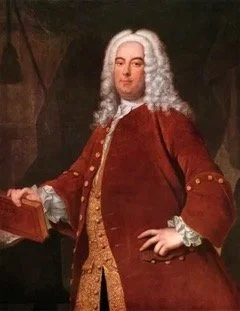Grace Notes
Volume 5
March 2025
George Frideric Handel
“One of the gifts of living in the Upper Valley, is the opportunity to hear unique and beautiful classical music. One example of this richness is Upper Valley Baroque, which includes world-class musicians on period instruments—a rare combination. Programming can also include a choir, solo instrumentalists and solo voices. Under the direction of Artistic Director Filippo Ciabatti, each performance is indeed a masterpiece—Bravo!”
L’Allegro, il Penseroso ed il Moderato
DONNA REILLY
If you’re not familiar with this remarkable work by George Frideric Handel, you can take comfort in knowing that you’re not alone. Handel composed it in early 1740, at a low point in his life. English audiences were beginning to tire of the Italian-style operas that Handel was producing—mostly because they were written using a form with which the English weren’t familiar (opera seria), in a language they didn’t understand (Italian). He had also recently suffered a stroke.
It’s difficult to know where to place L’Allegro within the vast body of Handel’s work. He had already written several works in English, but he was only beginning to develop the oratorio form by which he would eventually be so thoroughly identified. Instead, he succeeded in accomplishing this masterwork in English by taking what he’d learned in Italy about expressing emotions with the human voice and applying it to a libretto that is thoroughly English.
Billed as a “Pastoral Ode,” L‘Allegro, il Penseroso ed il Moderato (The Joyful Man, the Contemplative Man, and the Moderate Man) is based on John Milton’s great poems. Handel’s librettist, Charles Jennens, selected lines from Milton’s poems and wove them together in a way that sets up a dramatic dialogue within the first two parts. In an attempt to tie the parts together, the third, il Moderato, was added by Jennens, with poetry by Shakespeare and Jennens himself.
Handel occasionally performed orchestral concerti grossi between each part, but apparently the inclusion of these interludes depended upon circumstances such as performance length or availability of musicians. Today, that decision is one the conductor makes.
The work was an immediate hit in London, despite its Italian title. But L’Allegro is not performed often today, possibly because there are so many difficult solo parts. It doesn’t contain a major part for full chorus and is not included in most choral repertoires. There is no dramatic plot line and no cast of characters; the vocal parts are primarily solo arias—and some of the most beautiful you will ever hear. The drama in this work is provided by the human voice. In the words of Donald Teeters of Boston Cecilia, “…a vast palette of expressive language, an almost embarrassing richness of imagery and detail, from which Handel created a musical landscape of astounding beauty.
Sources: Martin Pearlman, Boston Baroque and Donald Teeters, Boston Cecilia
Table of Contents
Performing Handel’s L’Allegro : An Interview With Filippo Ciabatti
L’Allegro, il Penseroso ed il Moderato
Preview of April 5th and 6th Program
Musician Profiles: L’Allegro Soloists
Looking Back: Bach’s Brandenburg Concertos and Chamber Concerts
A Bach Family Affair: Organ Music by J. S. Bach and His Circle
GRACE NOTES

